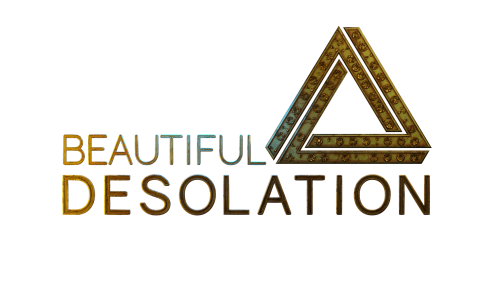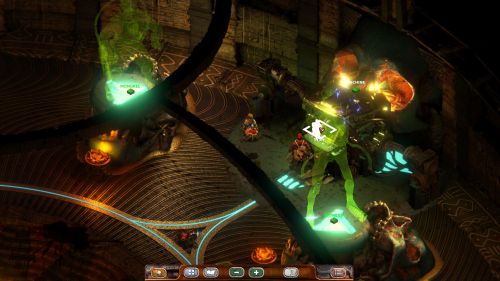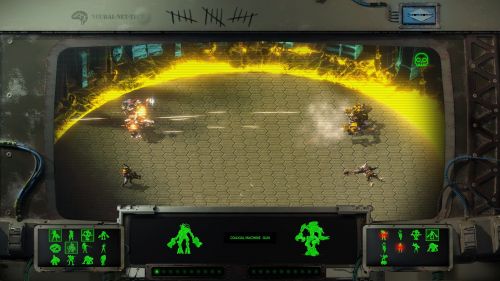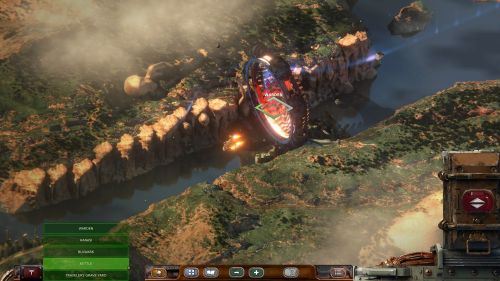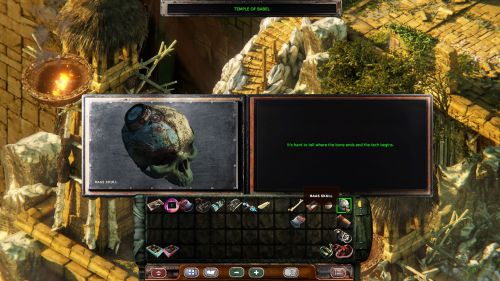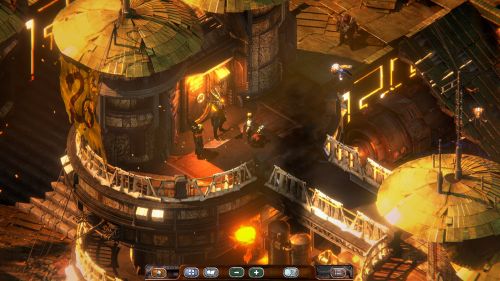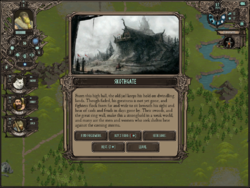RPG Codex Interview: Chris Bischoff on Beautiful Desolation
RPG Codex Interview: Chris Bischoff on Beautiful Desolation
Codex Interview - posted by Infinitron on Wed 26 February 2020, 19:18:26
Tags: Beautiful Desolation; Chris Bischoff; The Brotherhood[Interview by Infinitron]
To start things off, let’s assume we haven’t read anything about Beautiful Desolation. Tell us about the game’s setting. What year does it take place? What planet is it set on? Who are these two brothers and what are they doing there?
Beautiful Desolation is an adventure game set in the distant future - starting in the late 1970s, when a monolith of unknown origin - the Penrose - appeared in the skies of Cape Town, South Africa. This sends the world on an alternate path of technological growth, development, and eventual war.
The arrival of the Penrose resulted in the death of Mark Leslie's fiancé, later he pulls his brother into the mystery and his search for answers. Trying to figure out just what the Penrose is, who (if anyone) is responsible for its sudden arrival and disruption of the world.
Stasis and Cayne were obviously inspired by the Alien films and other sci-fi horror. What are the fictional inspirations for Beautiful Desolation?
There really were many, as we draw our inspiration from each book, film, game, etc., that we enjoy. If I’d run them off, I’d say Fallout, Mad Max, The Book of Eli, A Boy and his Dog, even painters like Albert Goodwin have had some sort of influence on the look of Beautiful Desolation.
The Tribal-punk African aesthetic was also something that we wanted to explore to give our world a unique flavor. South Africa is an incredible cultural melting pot, which made it the perfect setting for a new twist.
From a story angle, the game was definitely closer to Indiana Jones and other adventure movies of the 1980s, the hopeful science fiction of the 1950s with strange new worlds to explore, and new civilizations to discover. While we could’ve focused on the post-apocalyptic ruins of a previous civilization, we were more interested in what happens after that. What happens when the next settlement starts to rise from the rubble of the old? When the towns aren't quite burned out husks, but rather have new cultures growing and thriving?
Not fictional, but in our daily lives, we’ve seen the technological boom right before our eyes! We’ve seen how quickly new technologies can spread throughout a society and how those things can fundamentally alter their fabric, so this playing a part of our story was easy to imagine. In Beautiful Desolation, new cultures arise or adapt with almost ‘alien’ technology disseminated around the world.
In general, how would you characterize Beautiful Desolation’s puzzle design? You’ve probably got an entire puzzle design philosophy that you’ve developed over the years. Can you share it with us?
Early on we set up 3 pillars of the game – story, character, and exploration - and all of our choices had to support these three pillars. As long as the puzzles worked within that framework we knew that they’d feel connected in the game world.
We were heavily inspired by Star Control 2’s integration of the story and puzzles, and how the idea of holy relics drove their narrative forward.
Because Beautiful Desolation is more opened ended and nonlinear, we modified the more traditional ‘lock and key’ puzzle design to fit into a game where you can find any door and any key, in any order. So, in this game we focused on characters and their stories in the world and tried to ensure the puzzles revealed the story – rather than the puzzles blocking the player’s path forward.
Beautiful Desolation is an adventure game, but it’s clearly been influenced by the RPG genre. It’s got that isometric camera, a combat system, and most recently you revealed some Fallout-esque dialogue screens. This is the RPG Codex, so we obviously have to get all the details about that. What other RPG-inspired features does the game have? Why did you choose to go in this direction, and which RPGs specifically have you been inspired by?
Structurally we looked towards 90’s Adventure games and RPGs as a reference for an open world experience but with a structured story. Steering away from the linear adventure game format, we wanted Beautiful Desolation to be a game that could be replayed. In addition, something that would ensure that every player could have a unique playing experience - that they couldn't get from watching someone else play.
When we chose Character as one of our pillars of the game, it was a natural progression to add in dialogue trees. But how we hoped to change it up – to avoid a regular list of dialogue options that you can return to – was by focusing on a natural conversation flow. Our characters react not only to what you say to them, but how you say it.
I think there is a lot of room to expand ideas in the adventure game genre. What a great way to tell a story! I’ve enjoyed the world-building the most in this process. I’ve recently begun playing and hosting tabletop games, and to let players loose in these worlds and seeing what they do is so enjoyable. We hope to extend a taste of this with Beautiful Desolation.
Tell us more about the combat system. How does it work and how in-depth is it? Does it have stats and stuff? Which game’s combat system is it inspired by? And how often do you get to fight, anyway?
We approached the combat as a mini game, rather than as an integrated gameplay feature. The combat itself happens in an arena within the game story, run by a group that I can’t wait for you to meet, called The Five. Each combatant that you control in the game has their own series of abilities – some offensive, and others defensive. Along the main quest, you’ll get tokens which will give you access to the combatants in the arena. We tied the combat experience very tightly into the story, lore and history of the game as well as the relationships that you build by completing each story line. If you help the Nest and destroy the Moss then the Nest will provide a token to represent them in the arena. If you choose rather to support the Moss then they will be available. You might choose to support neither one which may also yield a different token oblation.
For those players that don’t enjoy mini games in their adventure games, the Arena quest is optional. However, the choice to not participate is as valid as the choice to participate – so don’t think it’s without repercussions in the story!
As for the inspiration for the system, we looked at everything from Hearthstone and GWENT to Final Fantasy, and everything in-between! We wanted to make it FUN and engaging to play and I think we got a good balance between simplicity and strategy. I’d love to expand on this aspect of our games in the future, so I’m looking forward to seeing player reactions to it.
RPGs tend to have multiple ways for solving obstacles, but that’s less common in adventure games. Does Beautiful Desolation offer multiple solutions for its puzzles?
Some puzzles have different solutions, but we decided to focus more on multiple outcomes of your overall choices. Once you’ve solved a puzzle, you have to decide what direction the story will go in, and who you’ll help or hinder.
How nonlinear is Beautiful Desolation? Does it have a big open world you can explore from the start? How about branching narrative, choice & consequence and multiple endings?
Beautiful Desolation starts off constrained to a few screens and slowly opens up. By the end you will have free rein to travel across multiple maps and numerous destinations. The idea was to imbue the player with the world’s sense of scale - and that feeling of being lost in a strange place.
Several of the game quests branch into different directions, where each choice you make alters how the world reacts to you. Some of the choices are minor, such as lying to someone to get a password from them, and others more impactful, like the decision to provide a group with a weapon of mass destruction. Multiple story threads are running concurrently so if you’re ‘stuck’ on one thread, you can move onto another.
As for Beautiful Desolation’s endings… that’s something you’re going to have to play to discover!
Stasis was a critically acclaimed title, but it was not without its criticisms. As I recall, there were a couple of posters on our forum who were particularly harsh towards it, in particular with regards to narrative, puzzles and the integration of the two. Are there any flaws of Stasis that you specifically sought to address in Beautiful Desolation?
Nic and I have been commercial artists for most of our careers, and taking on (and learning from) criticism is part of the job. If you can look at it objectively, it can only make your next project better.
As an example, certain opinions of STASIS were regarding the simplicity of its characters and story. We’ve certainly brought a more complex and reactive narrative with Beautiful Desolation forward, after taking this on board. Even now, we’re using the lesson learned from Beautiful Desolation’s development going forward into the planning of our next game.
I am still very proud of STASIS (and CAYNE), but like any artistic project I tend to only see where compromises were made. With Beautiful Desolation we took extra time to exceed our own expectations - and our final game far outstrips what I thought it would be when we first started writing it! We had to cut down several areas in STASIS from a narrative to time point of view but we were fortunate not to have this problem with Beautiful Desolation. It is the game we wanted to make.
Beautiful Desolation has been in development since at least 2016. Can you tell us a bit how the project has evolved over the years? Is it still more-or-less the same story you planned from the beginning or have there been multiple iterations, cut content and so on?
The main thread of the story has remained constant from our first discussions, but the way that story has been told went through much iteration. Some groups were merged into each other; certain areas were fleshed out further to open the world more… the result was richer world and game. We spent a lot of time solving problems that in retrospect seem so simple. How do we transition to a world map, how do we facilitate travel between larger maps, etc. Our games always put relationships first and foremost. The relationship between these two brothers is filled with abuse, betrayal and blame. You as the player can try to put things right between the siblings, or drive a bigger wedge between them. Mark is technophobic which doesn’t play well in a future ruled by robotic overlords. His relationship with Pooch is also pivotal to the story.
Things have changed a lot since we last interviewed you back in 2013. For a while back then it seemed like we were in a classic adventure game renaissance, fueled by Kickstarter hype and the Steam indie bubble. Seven years later, after seeing all those golden age developers on Kickstarter flame out one after the other, with Daedalic all but gone and Wadjet Eye increasingly streamlined, I think we’re all a lot more humble about the state of the genre. How do you think Beautiful Desolation fits in within this new (yet old) adventure game landscape?
I honestly have no idea! While it certainly is still an adventure game in my eyes, I think that it does cross over into other genres, and I’m excited to know how other people view that cross over. Maybe even attracting a few new players into adventure gaming!
Our goal has always been to tell interesting character driven stories against rich backdrops. Adventure games are an incredible vessel for that, but they also allow for a lot of innovation. I love the genre for its ability to tell amazing tales, and as long as there are stories to tell I think that there will always be adventure games.
Which part or aspect of Beautiful Desolation are you most proud of? Which part do you think Codexers will find most cool?
The world building of the game is something I’m extremely proud of. Each area has its own lore and history, and there is a lot of detail and environmental storytelling in the artwork. Beautiful Desolation tells a personal story on an epic backdrop of a world, with centuries of history behind it.
My hope is that players respond to how peculiar the world is. Whenever we got too close to a post-apocalyptic trope, we tried to put a unique spin on it. The world seems familiar but alien. I think that the Codex will find that aspect of Beautiful Desolation cool - that it feels different from anything else out there.
Finally, now that the game is done, what’s next for you?
If the game is successful, we would love to be able to move right into production of our next project! Although we may take a few weeks off to recharge… it's been a long three years!
To start things off, let’s assume we haven’t read anything about Beautiful Desolation. Tell us about the game’s setting. What year does it take place? What planet is it set on? Who are these two brothers and what are they doing there?
Beautiful Desolation is an adventure game set in the distant future - starting in the late 1970s, when a monolith of unknown origin - the Penrose - appeared in the skies of Cape Town, South Africa. This sends the world on an alternate path of technological growth, development, and eventual war.
The arrival of the Penrose resulted in the death of Mark Leslie's fiancé, later he pulls his brother into the mystery and his search for answers. Trying to figure out just what the Penrose is, who (if anyone) is responsible for its sudden arrival and disruption of the world.
Stasis and Cayne were obviously inspired by the Alien films and other sci-fi horror. What are the fictional inspirations for Beautiful Desolation?
There really were many, as we draw our inspiration from each book, film, game, etc., that we enjoy. If I’d run them off, I’d say Fallout, Mad Max, The Book of Eli, A Boy and his Dog, even painters like Albert Goodwin have had some sort of influence on the look of Beautiful Desolation.
The Tribal-punk African aesthetic was also something that we wanted to explore to give our world a unique flavor. South Africa is an incredible cultural melting pot, which made it the perfect setting for a new twist.
From a story angle, the game was definitely closer to Indiana Jones and other adventure movies of the 1980s, the hopeful science fiction of the 1950s with strange new worlds to explore, and new civilizations to discover. While we could’ve focused on the post-apocalyptic ruins of a previous civilization, we were more interested in what happens after that. What happens when the next settlement starts to rise from the rubble of the old? When the towns aren't quite burned out husks, but rather have new cultures growing and thriving?
Not fictional, but in our daily lives, we’ve seen the technological boom right before our eyes! We’ve seen how quickly new technologies can spread throughout a society and how those things can fundamentally alter their fabric, so this playing a part of our story was easy to imagine. In Beautiful Desolation, new cultures arise or adapt with almost ‘alien’ technology disseminated around the world.
In general, how would you characterize Beautiful Desolation’s puzzle design? You’ve probably got an entire puzzle design philosophy that you’ve developed over the years. Can you share it with us?
Early on we set up 3 pillars of the game – story, character, and exploration - and all of our choices had to support these three pillars. As long as the puzzles worked within that framework we knew that they’d feel connected in the game world.
We were heavily inspired by Star Control 2’s integration of the story and puzzles, and how the idea of holy relics drove their narrative forward.
Because Beautiful Desolation is more opened ended and nonlinear, we modified the more traditional ‘lock and key’ puzzle design to fit into a game where you can find any door and any key, in any order. So, in this game we focused on characters and their stories in the world and tried to ensure the puzzles revealed the story – rather than the puzzles blocking the player’s path forward.
Beautiful Desolation is an adventure game, but it’s clearly been influenced by the RPG genre. It’s got that isometric camera, a combat system, and most recently you revealed some Fallout-esque dialogue screens. This is the RPG Codex, so we obviously have to get all the details about that. What other RPG-inspired features does the game have? Why did you choose to go in this direction, and which RPGs specifically have you been inspired by?
Structurally we looked towards 90’s Adventure games and RPGs as a reference for an open world experience but with a structured story. Steering away from the linear adventure game format, we wanted Beautiful Desolation to be a game that could be replayed. In addition, something that would ensure that every player could have a unique playing experience - that they couldn't get from watching someone else play.
When we chose Character as one of our pillars of the game, it was a natural progression to add in dialogue trees. But how we hoped to change it up – to avoid a regular list of dialogue options that you can return to – was by focusing on a natural conversation flow. Our characters react not only to what you say to them, but how you say it.
I think there is a lot of room to expand ideas in the adventure game genre. What a great way to tell a story! I’ve enjoyed the world-building the most in this process. I’ve recently begun playing and hosting tabletop games, and to let players loose in these worlds and seeing what they do is so enjoyable. We hope to extend a taste of this with Beautiful Desolation.
Tell us more about the combat system. How does it work and how in-depth is it? Does it have stats and stuff? Which game’s combat system is it inspired by? And how often do you get to fight, anyway?
We approached the combat as a mini game, rather than as an integrated gameplay feature. The combat itself happens in an arena within the game story, run by a group that I can’t wait for you to meet, called The Five. Each combatant that you control in the game has their own series of abilities – some offensive, and others defensive. Along the main quest, you’ll get tokens which will give you access to the combatants in the arena. We tied the combat experience very tightly into the story, lore and history of the game as well as the relationships that you build by completing each story line. If you help the Nest and destroy the Moss then the Nest will provide a token to represent them in the arena. If you choose rather to support the Moss then they will be available. You might choose to support neither one which may also yield a different token oblation.
For those players that don’t enjoy mini games in their adventure games, the Arena quest is optional. However, the choice to not participate is as valid as the choice to participate – so don’t think it’s without repercussions in the story!
As for the inspiration for the system, we looked at everything from Hearthstone and GWENT to Final Fantasy, and everything in-between! We wanted to make it FUN and engaging to play and I think we got a good balance between simplicity and strategy. I’d love to expand on this aspect of our games in the future, so I’m looking forward to seeing player reactions to it.
RPGs tend to have multiple ways for solving obstacles, but that’s less common in adventure games. Does Beautiful Desolation offer multiple solutions for its puzzles?
Some puzzles have different solutions, but we decided to focus more on multiple outcomes of your overall choices. Once you’ve solved a puzzle, you have to decide what direction the story will go in, and who you’ll help or hinder.
How nonlinear is Beautiful Desolation? Does it have a big open world you can explore from the start? How about branching narrative, choice & consequence and multiple endings?
Beautiful Desolation starts off constrained to a few screens and slowly opens up. By the end you will have free rein to travel across multiple maps and numerous destinations. The idea was to imbue the player with the world’s sense of scale - and that feeling of being lost in a strange place.
Several of the game quests branch into different directions, where each choice you make alters how the world reacts to you. Some of the choices are minor, such as lying to someone to get a password from them, and others more impactful, like the decision to provide a group with a weapon of mass destruction. Multiple story threads are running concurrently so if you’re ‘stuck’ on one thread, you can move onto another.
As for Beautiful Desolation’s endings… that’s something you’re going to have to play to discover!
Stasis was a critically acclaimed title, but it was not without its criticisms. As I recall, there were a couple of posters on our forum who were particularly harsh towards it, in particular with regards to narrative, puzzles and the integration of the two. Are there any flaws of Stasis that you specifically sought to address in Beautiful Desolation?
Nic and I have been commercial artists for most of our careers, and taking on (and learning from) criticism is part of the job. If you can look at it objectively, it can only make your next project better.
As an example, certain opinions of STASIS were regarding the simplicity of its characters and story. We’ve certainly brought a more complex and reactive narrative with Beautiful Desolation forward, after taking this on board. Even now, we’re using the lesson learned from Beautiful Desolation’s development going forward into the planning of our next game.
I am still very proud of STASIS (and CAYNE), but like any artistic project I tend to only see where compromises were made. With Beautiful Desolation we took extra time to exceed our own expectations - and our final game far outstrips what I thought it would be when we first started writing it! We had to cut down several areas in STASIS from a narrative to time point of view but we were fortunate not to have this problem with Beautiful Desolation. It is the game we wanted to make.
Beautiful Desolation has been in development since at least 2016. Can you tell us a bit how the project has evolved over the years? Is it still more-or-less the same story you planned from the beginning or have there been multiple iterations, cut content and so on?
The main thread of the story has remained constant from our first discussions, but the way that story has been told went through much iteration. Some groups were merged into each other; certain areas were fleshed out further to open the world more… the result was richer world and game. We spent a lot of time solving problems that in retrospect seem so simple. How do we transition to a world map, how do we facilitate travel between larger maps, etc. Our games always put relationships first and foremost. The relationship between these two brothers is filled with abuse, betrayal and blame. You as the player can try to put things right between the siblings, or drive a bigger wedge between them. Mark is technophobic which doesn’t play well in a future ruled by robotic overlords. His relationship with Pooch is also pivotal to the story.
Things have changed a lot since we last interviewed you back in 2013. For a while back then it seemed like we were in a classic adventure game renaissance, fueled by Kickstarter hype and the Steam indie bubble. Seven years later, after seeing all those golden age developers on Kickstarter flame out one after the other, with Daedalic all but gone and Wadjet Eye increasingly streamlined, I think we’re all a lot more humble about the state of the genre. How do you think Beautiful Desolation fits in within this new (yet old) adventure game landscape?
I honestly have no idea! While it certainly is still an adventure game in my eyes, I think that it does cross over into other genres, and I’m excited to know how other people view that cross over. Maybe even attracting a few new players into adventure gaming!
Our goal has always been to tell interesting character driven stories against rich backdrops. Adventure games are an incredible vessel for that, but they also allow for a lot of innovation. I love the genre for its ability to tell amazing tales, and as long as there are stories to tell I think that there will always be adventure games.
Which part or aspect of Beautiful Desolation are you most proud of? Which part do you think Codexers will find most cool?
The world building of the game is something I’m extremely proud of. Each area has its own lore and history, and there is a lot of detail and environmental storytelling in the artwork. Beautiful Desolation tells a personal story on an epic backdrop of a world, with centuries of history behind it.
My hope is that players respond to how peculiar the world is. Whenever we got too close to a post-apocalyptic trope, we tried to put a unique spin on it. The world seems familiar but alien. I think that the Codex will find that aspect of Beautiful Desolation cool - that it feels different from anything else out there.
Finally, now that the game is done, what’s next for you?
If the game is successful, we would love to be able to move right into production of our next project! Although we may take a few weeks off to recharge… it's been a long three years!
There are 44 comments on RPG Codex Interview: Chris Bischoff on Beautiful Desolation





